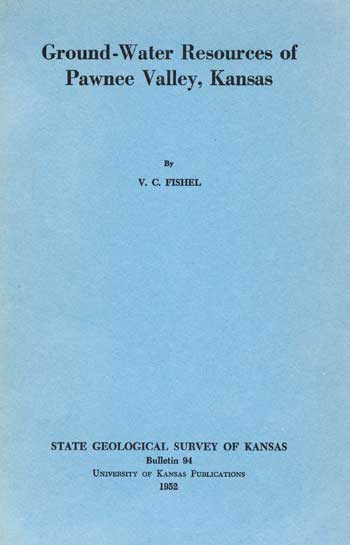Ground-water Resources of Pawnee Valley, Kansas
By V. C. Fishel

Originally published in 1952 as Kansas Geological Survey Bulletin 94. This is, in general, the original text as published. The information has not been updated.
Abstract
The report describes the ground-water resources of Pawnee Valley in Pawnee, Ness, and Hodgeman Counties in west-central Kansas. The hydrologic and geologic information was obtained in the field during the years 1944 to 1949, inclusive. The area consists of gently rolling upland plains together with relatively flat flood plains and terraces. The climate is subhumid, the average annual precipitation being between 20 and 24 inches. Farming and livestock raising are the principal occupations in the area. Irrigation from Pawnee River and from wells has been practiced extensively in Pawnee Valley.
The rocks that crop out in this area range in age from Cretaceous to Quaternary. The Cretaceous rocks are exposed in the uplands in northern Pawnee County and in the uplands adjacent to Pawnee Valley in Ness and Hodgeman Counties. The Ogallala formation crops out in the divide areas between Pawnee River and Buckner Creek and between Buckner Creek and Sawlog Creek. The alluvium and terrace deposits underlie the principal valleys and the adjacent areas. The alluvium yields large quantities of water to wells. Other formations generally yield only small to moderate quantities of water to wells.
In 1945 there were 132 irrigation wells in Pawnee Valley. These wells had yields ranging from about 400 to 1,900 gallons a minute. Pumping tests were made on nine wells to determine the yields of the wells and the permeability of the water-bearing materials. Data collected during the pumping tests and the analyses of the data from five of the tests are included in the report. Most of the wells constructed in recent years are single artificial gravel-pack or natural gravel-pack wells that penetrate all water-bearing materials above the Cretaceous bedrock. These wells are generally equipped with deep-well turbine pumps.
The saturated water-bearing materials of the alluvium have a maximum thickness of 120 feet. The volume of saturated water-bearing alluvium was determined for each township. A total of 1,145,000 acre-feet of water now in storage was estimated to be available for pumping. Records of groundwater levels and the stream flow of Pawnee River indicate that the available ground water exceeds the present withdrawal by pumping. The annual stream runoff in Pawnee Valley is about 36,000 acre-feet. If the water that is now discharged as stream flow is impounded and diverted to ground-water recharge, a maximum additional amount of 36,000 acre-feet could be available for pumping for irrigation.
Ground water in Pawnee Valley is usually hard, but is suitable for most uses. Waters from the Dakota formation generally contain large amounts of dissolved solids, but may be only moderately hard due to natural softening. The softer waters generally have a higher fluoride content. Water from the alluvium is hard but is of excellent quality for irrigation purposes.
The field data upon which this report is based are given in 22 tables. They include records of 316 wells, chemical analyses of water from 60 wells, and logs of 111 test holes.
Kansas Geological Survey, Geohydrology
Placed on web May 31, 2012; originally published April 1952.
Comments to webadmin@kgs.ku.edu
The URL for this page is http://www.kgs.ku.edu/Publications/Bulletins/94/index.html